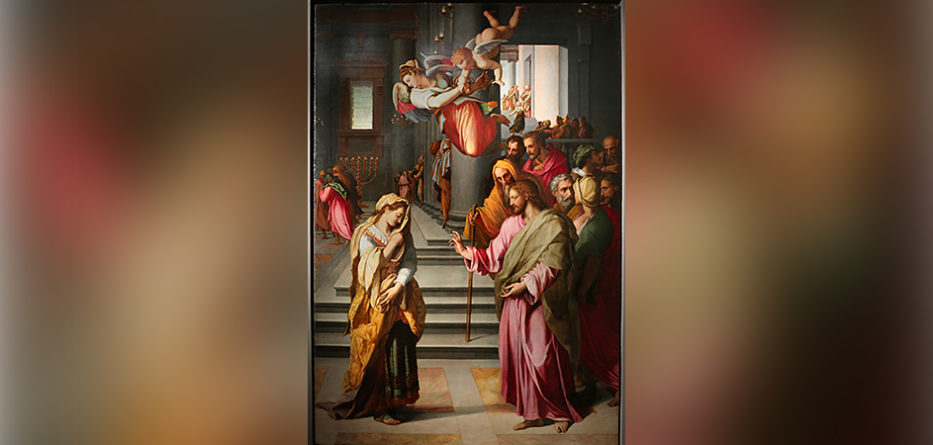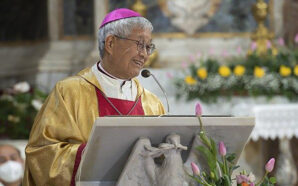Fifth Sunday of Lent
Readings: Isaiah 43:16-21; Psalm 125(126); Philippians 3:8-14; John 8:1-11
Sunday 3 April 2022
Breaking Open the Word
In our Gospel, a woman is caught in the very act of committing adultery. She is dragged before Jesus by the scribes and Pharisees and is humiliated, made to stand in full view of everybody. We don’t know her name, we don’t know anything else about her, but we do know she is in serious trouble. Her life is in danger, because according to the Law, anyone caught committing adultery was to be stoned to death. In fact, according to the Law, the person she was caught committing adultery with was also meant to be stoned to death (Dt 22:22–24), but there is no mention of the man. Perhaps he escaped or perhaps a trap had been deliberately set to catch the woman so that she might be used as bait to test Jesus’ own commitment to the Law (John 8:5–6). Either way, the woman is in a desperate situation. To make matters worse, according to the Law, only two witnesses were needed to convict a person and have them sentenced to death (cf. Dt 19:15). The woman never had two witnesses, she had an entire bunch of self-righteous scribes and Pharisees—the Law interpreters and the religious leaders of the day, pointing an accusing finger at her.
Jesus is also in a serious situation. He knows the Law given by God through Moses; he taught the Ten Commandments to others (Mt 19:16–19). In his Sermon on the Mount, not only did Jesus defend the Law, but he raised it to a new and higher level (Mt 5:27–28). So, if Jesus defends the woman, he could be accused of denying the Law, and contradicting himself, losing all credibility. If Jesus agrees with the Law, and with the punishment prescribed in the Law, Jesus is partly responsible for the death of the woman.
But when questioned by the scribes and Pharisees, Jesus responds by saying nothing. He says absolutely nothing. In fact, Jesus doesn’t even bother to look up. Instead, He bends down and writes with his finger on the ground. We have no idea what Jesus was writing. One suggestion is that Jesus was writing a list of sins—a reminder to the crowd that no one is free from guilt, and therefore no one in the crowd had the right to condemn the woman.
Personally, I don’t think Jesus was writing anything. I think he was making a really powerful gesture; scribbling on the ground to make a point. By pointing his finger into the ground, Jesus refuses to point the finger of blame at the woman. He doesn’t deny the Law; he just refuses to point the finger of blame. He refuses to have anything to do with the self-righteous crowd who are out to destroy, not just the reputation of another person, but the very life of another person. Likewise, we must be careful not to gossip or point the finger of blame lest we become part of the self-righteous crowd of scribes and Pharisees who take pleasure in ruining the lives and reputation of others.
When Jesus does eventually respond, he looks up and says, “If there is one of you who has not sinned let him be the first to throw a stone at her.” Jesus is without sin. He could have thrown the first stone, he could have pointed the finger of blame, but he doesn’t. Instead, he bends down once more and continues to write with his finger on the ground.
Jesus does not deny or change the Law. He does not deny the reality of sin. He doesn’t change the definition of what is right and wrong, after all, he tells the woman not to sin again. But, at the same time, Jesus refuses to condemn, he refuses to point the finger of blame. He speaks the Truth, but always with compassion.
Fr Antony Jukes OFM
Artwork Spotlight for personal reflection
Christ and the Adulteress (c. 1577) – Alessandro Allori (c. 1535–1607)
Christ and the Adulteress (c. 1577). Oil on wood, 73.3 x 55.5 cm. Basilica di Santo Spirito, Florence, Italy. Public Domain.
Alessandro Allori was one of the most prolific and active painters in late 16th-century Florence. His father, a sword maker, died when Alessandro was only five, and the painter, Agnolo Bronzino, was made guardian of the family. Agnolo virtually regarded Alessandro as his foster son, and in time, Alessandro would incorporate Bronzino’s name into his own.
In 1554, he left for Rome and carefully studied the works of Michelangelo and Raphael. Back in his native Florence, he became one of the principal painters for the ruling family of Florence, the Medici. With their protection, he was able to approach artists, writers and ecclesiastics. He would participate later in the funeral arrangements for Michelangelo who was buried in the Franciscan Church of Santa Croce in Florence. Alessandro died on 21 September 1607.
About 1577, Alessandro tackled the uncommon theme of Christ and the Adulteress, oil on wood, for the Basilica of Santo Spirito in Florence where it still hangs. The subject is rare in Gothic art. It certainly is one of the themes in the famous mosaics in the Cathedral of Monreale in Sicily. Alessandro would have been familiar with the recent decrees of the Council of Trent which demanded a faithfulness to the biblical texts in religious paintings for churches.
The Gospel text (Jn 8:1–11) is deliberately left out in most of the early manuscripts of the New Testament. The event was considered just too shocking—not the adultery itself, but Christ’s failure to accuse the woman. Surely God could not be that forgiving! Alessandro has very cleverly “written” this into his painting. Above the scene, an angel appears holding scales and a sword, representing the justice of God’s law, while a cherub seizes the angel’s sword hand to illustrate love and mercy controlling mere justice. The event happens in the Temple at Jerusalem where God had promised Solomon: “My heart will constantly be there” (2 Ch 7:16). Notice the seven-branched candlestick—the menorah—in the background.
The accusers were the scribes and Pharisees, but they end up becoming the accused as Christ bends down and writes on the ground. St John does not use the ordinary word “to write”—instead, he uses a word which can mean “to write against”, suggesting Jesus is confronting those self-confident sadists with a record of their own sins (notice the scornful look on the Pharisee on Jesus’ right. He seems to be saying, “Well, what are you going to do?”) The whole episode ends up as a mistrial by the failure of anyone to appear in the roles of the accuser or judge.
There is no evidence in the painting of Jesus writing on the ground. Alessandro has chosen to capture the initial moment of Christ confronting the woman. Between the two, there seems to be a moment of quiet and tender communion. The woman covers her face with her veil in shame. And that Christ was moved with pity for her plight cannot be doubted. St Augustine pithily put it: “There remained a great misery (miseria) and a great pity (misericordia).” Behind Jesus, a couple are eagerly discussing the situation—perhaps they were somehow related to the woman—and in the background, a woman runs off to tell her neighbours about the incident.
We could draw the wrong conclusion and gain the impression that Jesus forgave easily and lightly, as if the sin did not matter (in Jewish law, adultery was a serious crime, equated with idolatry and murder, and deserving the death penalty.) No, Jesus forgave the sin but added, “Go and sin no more.” As we saw on the third Sunday with the parable of the fig tree, God is the God of the second chance. He is not so much interested in what we have been, but in what we can be. God is always challenging us. He believes in us even when we do not believe in ourselves.
In her commentary on this text, Sr Verna Holyhead SGS asks some basic questions: “Are we tempted to use the sins of others to mask our own self-righteousness, our personal failures and limitations? Are there some of us still most condemnatory about those who sin against the two commandments that seem to be written larger than the other eight because they are concerned with things sexual? What we need to heap up in our own hearts and in our own Church is compassion that heals, not stones that hurt” (With Burning Hearts: Welcoming the Word in Year C, 41).
The ever-practical St James sums up this whole scene when he writes: “Mercy triumphs over judgment” (Ja 2:13).
Mgr Graham Schmitzer
Fr Antony Jukes OFM was raised in a Catholic family in Chingford, East London (the second of six children.) He was an altar server at his parish for many years, but found himself drifting from his faith during his years at university. After completing his studies, he worked as a trainee-chartered accountant in central London. It was on a pilgrimage to the shrine of Our Lady of Lourdes (France) that led him to rediscover his love for his Catholic faith and to question his vocation. His devotion to St Antony of Padua, after whom he was named, and his love for St Francis of Assisi, led him to join the Franciscan Order of Friars Minor in 2002. He studied philosophy and theology at what was the Franciscan International Study Centre in Canterbury, England, before being ordained a priest in 2009. Having served in a parish and in a youth retreat centre, Fr Antony is now the novice director at the international novitiate community in Killarney, Ireland.
Mgr Graham Schmitzer is a retired parish priest in the Diocese of Wollongong. He was ordained in 1969 and has served in the parishes of Campbelltown, Gwynneville, Unanderra, Wollongong, Albion Park, and Corrimal. He was also chancellor and secretary to Bishop William Murray for 13 years. He grew up in Port Macquarie and was educated by the Sisters of St Joseph of Lochinvar, completing his leaving certificate at Wauchope High School. For two years he worked for the Department of Attorney General and Justice before entering St Columba’s College, Springwood, in 1962. Fr Graham loves travelling and has visited many of the major art galleries in Europe.
With thanks to the Diocese of Wollongong, who have supplied these weekly Lenten 2022 reflections from their publication, Remember – Lenten Program 2022.








